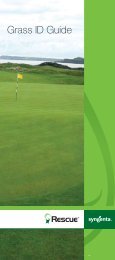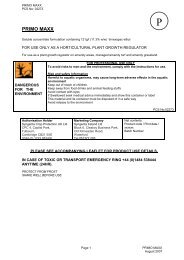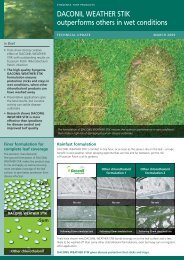Grass ID Guide - GreenCast
Grass ID Guide - GreenCast
Grass ID Guide - GreenCast
You also want an ePaper? Increase the reach of your titles
YUMPU automatically turns print PDFs into web optimized ePapers that Google loves.
p1<br />
<strong>Grass</strong> <strong>ID</strong> <strong>Guide</strong><br />
www.greencast.co.uk
p2<br />
Contents<br />
The Syngenta <strong>Grass</strong> Identification <strong>Guide</strong> p4<br />
<strong>Grass</strong> <strong>ID</strong> Decision Tree p6<br />
<strong>Grass</strong> <strong>ID</strong> Icons p8<br />
The <strong>Grass</strong> Species<br />
Perennial Ryegrass p10<br />
Yorkshire Fog p11<br />
Purple Moor-grass p12<br />
Fine Fescue p13<br />
Annual Meadow-grass p14<br />
Bentgrass p15<br />
Tufted Hair-grass p16<br />
Tall Fescue p17<br />
Sweet Vernal-grass p18<br />
Smooth-stalked Meadow-grass p19<br />
False Oat-grass p20<br />
Cocksfoot p21<br />
Summary p22<br />
RESCUE Programme p24<br />
What can you expect to see? p26<br />
p3<br />
www.greencast.co.uk
p4<br />
Syngenta <strong>Grass</strong><br />
Identification<br />
<strong>Guide</strong><br />
Accurate identification of grass species<br />
in your existing sward is essential before<br />
the use of RESCUE to determine:<br />
(a) Which grasses will be removed<br />
(b) How much turf cover will be removed<br />
(c) Which grasses will be left<br />
(d) The need for over seeding<br />
How to use this guide<br />
The easy to use Syngenta <strong>Grass</strong> Identification<br />
<strong>Guide</strong>, produced in conjunction with specialists<br />
from the Sports Turf Research Institute<br />
(STRI), provides a quick and reliable means to<br />
accurately assess the main turf grass species.<br />
The Syngenta <strong>Grass</strong> <strong>ID</strong> <strong>Guide</strong> is uniquely<br />
designed to help identify grass species in closely<br />
mown turf. Following a route of characteristic<br />
physiological features you will be able to<br />
determine the grass species present, and make<br />
a visual assessment of the sward composition.<br />
The <strong>Grass</strong> <strong>ID</strong> Decision Tree on pages 6 & 7 tracks<br />
through a logical sequence of characteristics to<br />
quickly and accurately determine the species.<br />
The <strong>Guide</strong> includes a set of novel, easy to<br />
remember visual icons (pages 8 & 9) of the<br />
key features to look out for with each species,<br />
along with clear guidance of the grass species<br />
which will be controlled with RESCUE.<br />
Designed in a format to keep with you during all<br />
turf assessments, identifying and recording grass<br />
species composition at different times of the year<br />
will give valuable practice and experience, as<br />
well as building a better picture and awareness<br />
of turf composition. Record patches of Ryegrass<br />
or other weed grass species throughout the<br />
season, to help prioritise treatment areas.<br />
If you are in any doubt over the grass<br />
species composition of your turf, consult<br />
your adviser before using RESCUE.<br />
p5<br />
www.greencast.co.uk
p6 p7<br />
Auricle: Some situations<br />
Ligule: Some situations<br />
No hairs<br />
Dull blue/<br />
green in colour<br />
False Oat-grass<br />
Leaf: Hairy, Spiky and needle-like,<br />
Tramlines, Crinkled, Wide and flat leaf<br />
Smooth leaf<br />
Hairs<br />
Fringe of hairs<br />
instead of ligule<br />
Purple<br />
Moor-grass<br />
Lower leaf surfaces: Shiny, Dull<br />
Upper leaf surfaces: Ribbed, Smooth<br />
Short ligule<br />
Stem base colour: Red/purple, Pink, Green<br />
Sweet<br />
Vernal-grass<br />
Key <strong>ID</strong> features<br />
which work at relevant<br />
heights of cut:<br />
Hairy auricles<br />
Tall Fescue<br />
Leaf emerges<br />
rolled<br />
Ribbed leaf<br />
Long pointed<br />
ligule<br />
Tufted Hairgrass<br />
Hairless leaf<br />
Leaf with<br />
dull back<br />
Bentgrass<br />
Soft hairy leaf<br />
Pink striped<br />
stem base<br />
Yorkshire Fog<br />
Start Stem<br />
Spiky and<br />
needle-like leaf<br />
Fine Fescue<br />
Tramlines<br />
on leaf<br />
Smooth leaf<br />
Short ligule<br />
Smooth-stalked<br />
Meadow-grass<br />
Crinkled leaf<br />
Large ligule<br />
Annual<br />
Meadow-grass<br />
Leaf emerges<br />
folded<br />
Wide and<br />
flat leaf<br />
Dull pale<br />
green leaf<br />
Hairy ligule<br />
Cocksfoot<br />
Leaf with<br />
shiny back<br />
Red/purple<br />
stem base<br />
Auricle present<br />
Perennial<br />
Ryegrass<br />
<strong>Grass</strong> <strong>ID</strong> Decision Tree
p8<br />
<strong>Grass</strong> <strong>ID</strong> icons<br />
General features to look for:<br />
Is the emerging leaf rolled or folded<br />
in the shoot – when you twist the stem<br />
between your thumb and finger does it<br />
‘judder’ or roll smoothly like spaghetti?<br />
Is the leaf blade ribbed?<br />
Is the underside of the leaf shiny?<br />
Is the leaf blade hairy?<br />
Is the leaf spiky and needle-like?<br />
Does the leaf have tramlines?<br />
Is there any colouration at the<br />
base of the stem?<br />
Are there any auricles - clasp like projections<br />
(like the pointed tips of a shirt collar) where<br />
the leaf blade joins the leaf sheath?<br />
Are there any ligules - a pale membrane<br />
(like the back section of a shirt collar) where<br />
the leaf blade joins the leaf sheath?<br />
Inflorescence – is it a panicle or spike?<br />
Are there any stolons (above ground<br />
creeping stems) or rhizomes<br />
(underground creeping stems)?<br />
What icons<br />
to look out for<br />
EMERGING LEAF FOLDED<br />
W<strong>ID</strong>E AND FLAT LEAF<br />
RIBBED LEAF<br />
DULL LEAF<br />
AURICLE<br />
LONG AND POINTED LIGULE<br />
RED STRIPED STEM BASE<br />
EMERGING LEAF ROLLED<br />
TRAMLINES ON LEAF<br />
HAIRLESS LEAF<br />
CRINKLED LEAF<br />
HAIRY AURICLES<br />
LONG LIGULE<br />
RED STEM BASE<br />
p9<br />
SHINY LEAF<br />
SPIKY & NEEDLE-LIKE LEAF<br />
HAIRY LEAF<br />
SMOOTH LEAF<br />
HAIRY LIGULE<br />
SHORT LIGULE<br />
www.greencast.co.uk
Key identifiers<br />
p10<br />
PerennIAL ryeGrASS<br />
Lolium perenne<br />
1 2<br />
3<br />
1<br />
2<br />
Youngest leaf<br />
folded in shoot<br />
Leaves shiny on<br />
underside 1<br />
Upper surface<br />
of leaf very<br />
strongly ribbed<br />
EMERGING LEAF FOLDED<br />
CONTROLLED by RESCUE<br />
SHINY LEAF<br />
Can be confused with:<br />
Red stem base 2<br />
Auricles present<br />
Inflorescence –<br />
Spike 3<br />
Susceptible to<br />
Leaf Spot<br />
RED STEM BASE<br />
AURICLE<br />
Bentgrass (page 15) – With Ryegrass look for the<br />
youngest leaf folded (not rolled) and a shiny leaf<br />
underside, compared to dull Bentgrass leaves.<br />
The red stem base is characteristic of Ryegrass<br />
Key identifiers<br />
yorKSHIre FoG<br />
Holcus lanatus<br />
p11<br />
CONTROLLED by RESCUE* (See summary page)<br />
Youngest leaf<br />
rolled in shoot 1<br />
Soft grey/green<br />
hairy leaves<br />
Pink/purple stripes<br />
on leaf sheath,<br />
especially at the<br />
stem base 2<br />
EMERGING LEAF ROLLED<br />
HAIRY LEAF<br />
Can be confused with:<br />
Obvious ligule 3<br />
Inflorescence<br />
– Panicle<br />
Susceptible to<br />
Crown Rust<br />
RED STRIPED STEM BASE<br />
Bentgrass (page 15) – look for dense hairs<br />
and pink stripy stem base on Yorkshire Fog<br />
www.greencast.co.uk<br />
3
Key identifiers<br />
p12<br />
PUrPLe moor-GrASS<br />
Molinia caerulea<br />
CONTROLLED by RESCUE* (See summary page)<br />
Youngest leaf<br />
rolled in shoot<br />
Upper leaf smooth<br />
with no ribs<br />
Leaves hairy 1<br />
Ligule present<br />
but a line of hairs<br />
rather than a<br />
membrane 2<br />
EMERGING LEAF ROLLED<br />
1<br />
SMOOTH LEAF<br />
Can be confused with:<br />
Inflorescence<br />
– Panicle but<br />
may be dense<br />
resembling a spike<br />
Mostly found in wet<br />
moorland, heaths,<br />
commons and fens<br />
HAIRY LEAF<br />
Yorkshire Fog (page 11) – look for the<br />
ligule in Yorkshire Fog; Purple Moorgrass<br />
has just short hairs instead<br />
HAIRY LIGULE<br />
2<br />
Key identifiers<br />
1<br />
FIne FeScUe<br />
Festuca Species<br />
NOT AFFECTED by RESCUE<br />
Spiky, needlelike<br />
leaves 1<br />
Leaf sheath tubular<br />
Inflorescence –<br />
Panicle 2<br />
Slender Creeping<br />
Red Fescue –<br />
rhizomes present,<br />
very fine leaves<br />
SPIKY & NEEDLE-LIKE LEAF<br />
p13<br />
Chewings Fescue<br />
– no rhizomes,<br />
very fine leaves<br />
Strong Creeping<br />
Red Fescue –<br />
rhizomes present,<br />
coarser leaves<br />
Susceptible to<br />
Dollar Spot and<br />
Red Thread<br />
www.greencast.co.uk<br />
2
Key identifiers<br />
p14<br />
AnnUAL meADoW-GrASS<br />
Poa annua<br />
1<br />
NOT AFFECTED by RESCUE<br />
Youngest leaf<br />
folded in shoot<br />
Tramlines on leaf<br />
Older leaves<br />
often ‘crinkled<br />
in centre’ 1<br />
Large ligule<br />
EMERGING LEAF FOLDED<br />
TRAMLINES ON LEAF<br />
Can be confused with:<br />
Inflorescence –<br />
Panicle. Often in<br />
flower in mown turf,<br />
even at very short<br />
heights of cut 2<br />
Susceptible to<br />
Fusarium Patch<br />
and Anthracnose<br />
CRINKLED LEAF<br />
Smooth-stalked Meadow-grass (page<br />
19) – look for large ligule, paler colour and<br />
leaf softness in Annual Meadow-grass<br />
LONG LIGULE<br />
2 1<br />
Key identifiers<br />
p15<br />
BenTGrASS<br />
Agrostis Capillaris (Browntop/Colonial)<br />
Occasional temporary yellowing/browning following<br />
RESCUE application – usually outgrown in 7–10 days<br />
Youngest leaf<br />
rolled in shoot<br />
Upper leaf blade<br />
ribbed 1<br />
Leaves hairless<br />
Leaves dull on<br />
underside<br />
EMERGING LEAF ROLLED<br />
RIBBED LEAF<br />
Can be confused with:<br />
Inflorescence<br />
– Panicle<br />
Spread by stolons<br />
or rhizomes 2<br />
Susceptible to<br />
Fusarium Patch<br />
and Take-all Patch<br />
HAIRLESS LEAF<br />
Yorkshire Fog (Page 11) – look for hairy leaves<br />
and red/purple at stem base of Yorkshire<br />
Fog, which are not present in Bentgrass<br />
Perennial Ryegrass (Page 10) – look<br />
for the shiny leaf of Ryegrass compared<br />
to the dull leaf of Bentgrass<br />
DULL LEAF<br />
www.greencast.co.uk<br />
2
Key identifiers<br />
p16<br />
1<br />
TUFTeD HAIr-GrASS<br />
Deschampsia caespitose<br />
NOT AFFECTED by RESCUE<br />
Youngest leaf<br />
rolled in the shoot<br />
Hairless leaf<br />
Leaves strongly<br />
ribbed and rough,<br />
tapering to a<br />
pointed tip 1<br />
EMERGING LEAF ROLLED<br />
RIBBED LEAF<br />
Can be confused with:<br />
Ligule present,<br />
very long and<br />
pointed 2<br />
Inflorescence<br />
– Panicle<br />
HAIRLESS LEAF<br />
LONG AND POINTED LIGULE<br />
Tall Fescue (page 17) - Tufted Hair-grass does<br />
not have the hairy auricles of Tall Fescue<br />
2 1<br />
Key identifiers<br />
TALL FeScUe<br />
Festuca arundinacea<br />
NOT AFFECTED by RESCUE<br />
Youngest leaf<br />
rolled in shoot<br />
Leaves strongly<br />
ribbed 1<br />
Older leaves wide<br />
and flat, tapering<br />
to a point<br />
EMERGING LEAF ROLLED<br />
RIBBED LEAF<br />
Can be confused with:<br />
p17<br />
Hairy auricles 2<br />
Ligule present<br />
Inflorescence<br />
– Panicle<br />
HAIRY AURICLES<br />
Perennial Ryegrass (page 10) – look for<br />
hairs on auricles and ligule of Tall Fescue<br />
Tufted Hair-grass (page 16) – look for auricles,<br />
which are not present on Tufted Hair-grass<br />
www.greencast.co.uk<br />
2
Key identifiers<br />
p18<br />
1<br />
SWeeT vernAL-GrASS<br />
Anthoxanthum odoratum<br />
NOT AFFECTED by RESCUE<br />
Youngest leaf<br />
rolled in shoot<br />
Ribbed leaf<br />
Leaves are loosely<br />
hairy 1<br />
Ligule present<br />
EMERGING LEAF ROLLED<br />
RIBBED LEAF<br />
Inflorescence –<br />
Spike 2<br />
Flowers early<br />
in spring<br />
When leaves are<br />
crushed they have a<br />
very strong ‘mown<br />
grass’ smell<br />
SHORT LIGULE<br />
2 1<br />
2<br />
3<br />
Key identifiers<br />
p19<br />
SmooTH-STALKeD meADoW-GrASS<br />
Poa pratensis<br />
Occasional temporary yellowing/browning following<br />
RESCUE application – usually outgrown in 7–10 days<br />
Youngest leaf<br />
folded in shoot<br />
Tramlines visible<br />
on either side<br />
of the leaf blade<br />
mid-rib 2<br />
Smooth leaf<br />
EMERGING LEAF FOLDED<br />
TRAMLINES ON LEAF<br />
Can be confused with:<br />
Boat shaped<br />
leaf tip 1<br />
Short ligule<br />
Inflorescence<br />
- Panicle<br />
Rhizomes<br />
present 3<br />
SMOOTH LEAF<br />
SHORT LIGULE<br />
Annual Meadow-grass (page 14) – look for small<br />
ligule, stiff dark green leaves and the presence<br />
of rhizomes not seen in Annual Meadow-grass<br />
www.greencast.co.uk
Key identifiers<br />
p20<br />
FALSe oAT-GrASS<br />
Arrhenatherum elatius<br />
NOT AFFECTED by RESCUE<br />
Youngest leaf<br />
rolled in shoot<br />
Smooth, dull bluegreen<br />
leaves<br />
Very coarse grass<br />
Ligule present 1<br />
Inflorescence –<br />
Panicle 2<br />
EMERGING LEAF ROLLED<br />
1 2<br />
SMOOTH LEAF<br />
Onion couch<br />
sub-species of<br />
Arrhenatherum<br />
elatius has bulbous<br />
swellings at the<br />
base (resembling<br />
small onions)<br />
Very difficult grass<br />
to eradicate<br />
HAIRLESS LEAF<br />
DULL LEAF<br />
Key identifiers<br />
cocKSFooT<br />
Dactylis glomerata<br />
p21<br />
1 2 3<br />
NOT AFFECTED by RESCUE<br />
Youngest leaf<br />
folded in shoot 1<br />
Leaves wide<br />
and flat<br />
Flat stem<br />
EMERGING LEAF FOLDED<br />
W<strong>ID</strong>E AND FLAT LEAF<br />
Can be confused with:<br />
Dull, pale green<br />
leaf 2<br />
Hairy ligule 3<br />
Inflorescence<br />
– Panicle<br />
DULL LEAF<br />
Annual Meadow-grass (page 14) - Look for<br />
the wide, flat of Cocksfoot compared to the<br />
soft crinkled leaves of Annual Meadow-grass<br />
HAIRY LIGULE<br />
www.greencast.co.uk
p22<br />
Summary<br />
RESCUE is an exciting new selective<br />
herbicide from Syngenta, for the control of<br />
Ryegrass infestations in fine turf swards.<br />
RESCUE controls Ryegrass, but is uniquely<br />
safe to Fescues and Poa Annua.<br />
Occasionally some temporary yellowing may<br />
be seen on Colonial/Browntop Bentgrass<br />
and Smooth-stalked Meadow-grass following<br />
RESCUE application; this effect is transient and<br />
is quickly outgrown in good conditions. Highland<br />
Bent has however shown some susceptibility.<br />
For the first time, golf course managers<br />
have the opportunity to effectively remove<br />
invasive clumpy Ryegrass that adversely<br />
affects the quality and playability of turf.<br />
Benefits of RESCUE<br />
Removes Ryegrass and some<br />
other invasive grass species<br />
Safe for use on Fescues, Poa Annua<br />
and some other fine turf species<br />
Specifically developed for golf<br />
course applications<br />
By following the RESCUE Programme Ryegrass<br />
can be removed and, with the help of over<br />
seeding, reinstate finer species to improve<br />
turf quality on all areas of the course.<br />
RESCUE is approved for use across<br />
the golf course, including:<br />
Greens Semi-rough and rough<br />
Tees Fairways<br />
p23<br />
RESCUE has been extensively trialled and<br />
proven on all golf course types to help improve<br />
turf quality and playing surfaces where invasive<br />
Ryegrass and coarse grasses cause problems.<br />
* Trials have shown RESCUE can also control<br />
some other undesirable coarse grasses,<br />
including Yorkshire Fog and Purple Moor-grass.<br />
RESCUE<br />
Effectively controls of Ryegrass<br />
Restores high quality, fine playing surfaces<br />
Reduces other invasive coarse grasses<br />
Leaves Fescues and Poa Annua unaffected<br />
Replaces expensive, time-consuming<br />
and ineffective conventional<br />
Ryegrass reduction techniques<br />
Allows rapid rejuvenation of fine turf surfaces<br />
Easy to use formulation<br />
www.greencast.co.uk
p24 p25<br />
For best results<br />
commence the<br />
RESCUE programme<br />
in the autumn,<br />
when conditions<br />
are conducive<br />
for effective<br />
Ryegrass control<br />
and successful<br />
over seeding.<br />
For best results RESCUE<br />
should be used in<br />
conjunction with a PRIMO<br />
MAXX programme to<br />
encourage fast recovery<br />
and improve turf quality. For<br />
autumn treatment, make the<br />
season’s final PRIMO MAXX<br />
application three to five<br />
days prior to over seeding.<br />
For applications in the<br />
spring, apply RESCUE<br />
when turf is actively growing<br />
to encourage uptake<br />
into target Ryegrasses –<br />
typically from end-April<br />
to end-June when air<br />
and soil temperatures are<br />
consistently above 8–10°C.<br />
For spring RESCUE treatments,<br />
apply the first PRIMO MAXX<br />
application three to five days,<br />
prior to over seeding. Routine<br />
applications of PRIMO MAXX<br />
can commence when new<br />
seedlings are at the two trueleaf<br />
stage, around 80-90%<br />
ground cover and continue<br />
through the growing season.<br />
RESCUE applications<br />
should be completed<br />
by mid to end of<br />
October to allow<br />
turf recovery.<br />
Programme start<br />
PRIMO MAXX aids<br />
overseeding<br />
Wait for active growth<br />
PRIMO MAXX programmes<br />
Autumn end<br />
Autumn Treatment Window Spring Treatment Window<br />
Autumn Treatment Window<br />
September October November<br />
April May June July August September October November<br />
Trials have shown that<br />
autumn applications of<br />
RESCUE give the highest<br />
levels of control.<br />
The RESCUE Programme can also be started<br />
in the spring, although trials have shown<br />
that starting the Programme in the autumn<br />
is generally the most effective. Any soft regrowth<br />
following autumn applications can be<br />
successfully treated in the spring. This gives a<br />
good opportunity for remaining fine turf plants<br />
to spread and for successful over seeding to<br />
fill in gaps left when the Ryegrass is killed.<br />
A subsequent autumn<br />
treatment may be beneficial to<br />
control heavy, well established<br />
weed Ryegrass populations.<br />
Follow up RESCUE treatments<br />
may be required where new<br />
Ryegrass seedlings germinate and<br />
establish. A successful over seeding<br />
programme and applications of<br />
PRIMO MAXX to encourage a<br />
thicker sward will minimise the<br />
chance of Ryegrass reinfestation.<br />
Autumn Treatment<br />
Spring Treatment<br />
Autumn Treatment<br />
Follow-up Treatments<br />
The reScUe Programme<br />
Best results: Autumn Window Alternative: Spring Window
p26 p27<br />
Ryegrass<br />
infestations on<br />
fine turf create<br />
an uneven and<br />
unsightly surface<br />
that is difficult<br />
to maintain and<br />
unpopular with<br />
players. RESCUE<br />
application is a<br />
quick and effective<br />
route to restoring<br />
fine turf quality.<br />
Ryegrass and other<br />
susceptible weed<br />
grasses start to<br />
go pale yellow and<br />
begin to die back.<br />
Do the “RESCUE<br />
Rub Test”. When<br />
the treated patches<br />
have died back,<br />
rub the patch with<br />
the palm of your<br />
hand. If the treated<br />
turf surface breaks<br />
up it has ‘passed’<br />
the RESCUE Rub<br />
Test. Any temporary<br />
yellowing on<br />
Bentgrasses should<br />
be outgrown.<br />
Over seeding of treated<br />
areas is an important<br />
element of the RESCUE<br />
programme. Having passed<br />
the Rub Test the surface<br />
is ready for an application<br />
of PRIMO MAXX and<br />
subsequent over seeding<br />
five days later. Over seed<br />
with an appropriate mix<br />
to match or enhance the<br />
existing sward. Ideally use<br />
an over seeding machine<br />
such as a slot seeder, to drill<br />
seed into the rootzone and<br />
improve soil : seed contact.<br />
Target Ryegrass<br />
and other weed<br />
grasses will have<br />
died right back.<br />
Over seeding<br />
should have<br />
taken place<br />
and, in good<br />
conditions,<br />
new seedlings<br />
will be starting<br />
to emerge.<br />
Ryegrass and<br />
other grass weed<br />
species will have<br />
been controlled.<br />
Any plants that<br />
have survived<br />
treatment will show<br />
weakened growth<br />
and susceptibility to<br />
a second RESCUE<br />
application.<br />
Seedlings from<br />
over seeding<br />
programmes should<br />
be well established.<br />
Before<br />
application<br />
Two to three weeks<br />
after application<br />
Three to five weeks<br />
after application<br />
Three to five weeks -<br />
PRIMO MAXX and over<br />
seeding programmes<br />
Five to eight<br />
weeks after<br />
application<br />
Eight to ten<br />
weeks after<br />
application<br />
The removal of Ryegrasses and other<br />
unwanted coarse grasses allow the successful<br />
re-establishment and maintenance of a<br />
high quality, fine turf playing surface.<br />
The Finished Result<br />
What can you expect to see?
Syngenta Crop Protection UK Ltd.<br />
Registered in England, No 849037, CPC4,<br />
Capital Park, Fulbourn, Cambridge, CB21 5XE.<br />
RESCUE® is a Registered Trademark of<br />
a Syngenta Group Company. RESCUE®<br />
(MAPP 14518) contains pinoxaden.<br />
Always read the label. Use pesticides<br />
safely. ©Syngenta AG July 2009. GQ 00485.<br />
Distributed in the UK by<br />
Scotts Professional<br />
Tel: 0871 220 5353<br />
Email: prof.sales@scotts.com<br />
www.greencast.co.uk











